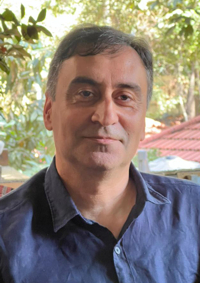Zagros Gebirge, Iran (z Z nicht angeboten)
Veranstalter: Mahyar Mohtadi
15-day field trip
Total costs: about 500 € including all boards and transfer/lodging. Subject to changes in the exchange rate of the Iranian currency (Rial).
This field trip focuses on
a) the largest mass extinction event in shallow marine environments at the Paleozoic-Mesozoic boundary (Permian-Triassic Boundary);
b) genesis and exploration of oil and gas, their source rocks (lower Cretaceous to Early Tertiary shales and marls) reservoir rocks (upper Cretaceous to early Tertiary carbonates), and cap rocks (evaporites);
c) genesis and tectonic of salt domes and diapirs; and
d) transport and deposition mechanisms in eolian system, formation and types of sand dunes and sandstones, ripple marks, evaporative crusts, etc.
Program:
The field trip will start with the THY-flight Bremen-Istanbul-Isfahan (1 day), followed by 6 days in central Iran and 7 days in south Iran, and ends with the return flight Shiraz-Istanbul-Bremen (1 day).
The students will gain knowledge on petroleum geology, formation and exploration of oil and gas, carbonate rocks, their classification and factors controlling their porosity/permeability, formation and tectonic of salt domes and salt diapirs, Alpine orogeny and the associated tectonic processes in the Zagros Mountains, inner and outer ophiolites and their composition, transport and deposition mechanisms in eolian systems, and mass extinction events in Earth history.
Writing a report for particular days of the field trip, will be assigned at the end of the field trip.
Exkursionsbericht
Wird als Download zur Verfügung gestellt
Unterstützende digitale Lehrmaterialien verfügbar
1. Tag: Flight Bremen-Istanbul-Isfahan
2. Tag: Carboniferous-Permian and Permian-Triassic boundaries near Shahreza, largest mass extinction in Earth history “the big dying”
3. Tag: Soffeh Mountain in Isfahan, slightly metamorphic lower Cretaceous carbonates
4. Tag: Mid- to upper Cretaceous ophiolites (inner ophiolites) near Nayeen
5. Tag: Urmia-Dokhtar Magmatic Arc (UDMA) Paleocene-Oligocene NE of Isfahan, regional tectonic and fault systems
6. Tag: Gavkhouni Playa SE of Isfahan, desertification, sand dunes and aeolian deposits
7. Tag: Departure Isfahan in the morning, arrival Shiraz in the afternoon
8. Tag: Stratigraphic profile from mid-Cretaceous to recent, perpendicular to the main folding axis of Zagros. Source, reservoir, and cap rocks of the world’s most famous conventional oil reservoirs, fold and fault systems governing the morphology of oil traps
9. Tag: Jashak salt diapir, Lahbari member (molasse) and its weathering features near Bushehr
10. Tag: Main folding axis of Zagros (1), lateral stratigraphic and sedimentologic changes and source units in Fars near Shiraz
11. Tag: Main folding axis of Zagros (2), lateral stratigraphic and sedimentologic changes and reservoir units in Fars near Sarvestan
12. Tag: Ophiolite (outer) systems and evidence of the closure of Tethys around Neyriz
13. Tag: Jahani salt diapir in Firouzabad, sedimentary successions including dissolution enhancing reservoir qualities in Farashband
14. Tag: Visiting Persepolis and Naqsh-e-Rostam and outcrops on the way
Gefüge-Kompasse
Eckdaten
05-MAG-PG2-6
Studiengang
Master Applied Geosciences
Modulname
Gelände- und Laborpraxis
Veranstaltungsart
Geländeübung (GÜ)
1. Studienjahr
6 CP
6 SWS
Sommersemester
Kurssprache(n)
Deutsch und Englisch
Ansprechpartner

Klimavariabilität der niedrigen Breiten
PD Dr. Mahyar Mohtadi
MARUM2 3100R
Tel.: +49 421 218 - 65660
mohtadi uni-bremen.de
uni-bremen.de
Klimavariabilität der niedrigen Breiten
PD Dr. Mahyar Mohtadi
MARUM2 3100R
Tel.: +49 421 218 - 65660
mohtadi uni-bremen.de
uni-bremen.deVeranstalter

Klimavariabilität der niedrigen Breiten
PD Dr. Mahyar Mohtadi
MARUM2 3100R
Tel.: +49 421 218 - 65660
mohtadi uni-bremen.de
uni-bremen.de
Klimavariabilität der niedrigen Breiten
PD Dr. Mahyar Mohtadi
MARUM2 3100R
Tel.: +49 421 218 - 65660
mohtadi uni-bremen.de
uni-bremen.de
